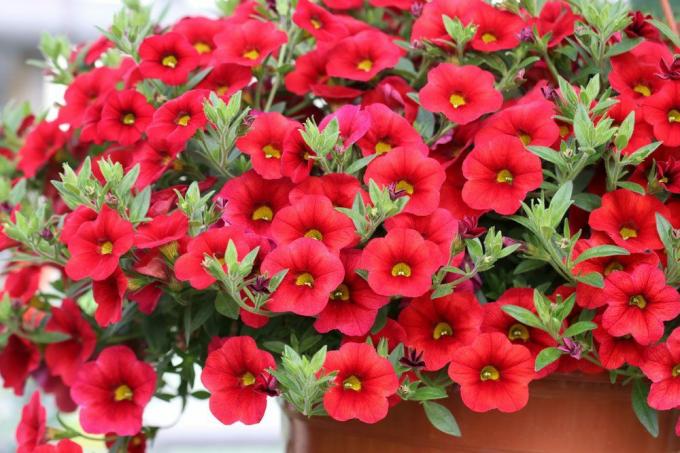
table of contents
- Location
- care
- Flowering and flowering period
- Substrate
- plants
- to water
- Fertilize
- Cut
- Overwinter
- Multiply
- Diseases
Profile and care information open +conclude -
- Flower color
- yellow, orange, pink, red, violet, white, blue
- Location
- Partial shade, shady, sunny
- Heyday
- May, June, July, August, September
- Growth habit
- upright, spreading, bushy, perennial, overhanging
- height
- up to 60 centimeters high
- Soil type
- loamy, gritty
- Soil moisture
- moderately moist, fresh
- PH value
- weakly sour, sour
- Limescale tolerance
- Calcium intolerant
- humus
- rich in humus
- Poisonous
- Yes
- Plant families
- Nightshade family, Solanaceae
- Plant species
- Bedding plants, balcony plants
- Garden style
- Residential garden, flower garden, roof garden
Magic bells, mini petunias, millionbells or calibrachoa - it is worth buying the nightshade plant with the many names. With adequate care, the dense, hanging shoots and the associated large flowers make the plant a real eye-catcher. It is considered to be relatively undemanding. Nevertheless, there are some basic requirements to be met - only then can the magic bell live up to its name and develop all of its beauty.
Location
The magic bell wants a sunny spot to the south as possible. If it receives this, the plant shows an extremely abundant flowering - and that over a long period of time. However, the Calibrachoa is satisfied with partial shade and thrives well under appropriate conditions. The location shouldn't be too protected, especially since the Millionbells have no problem with moderate wind and rain. Even the delicate flowers usually withstand these influences without further ado.

care
Flowering and flowering period
The magic bell presents its lavish abundance of flowers from May to October. If it does not bloom as desired, this can have various causes.
- missing sun
- too little water and nutrients
- too wet soil
Traffic light or bucket
The magic bell is a plant that grows hanging. The shoots of the mini petunia can reach a length of up to 60 centimeters. For these reasons, it is advisable to cultivate the plant in a traffic light. Alternatively, the bucket can also be used, provided that it is placed high enough - for example on a pedestal.
Substrate
Millionbells love loose, nutrient-dense, and slightly acidic substrate - a desire that is quite easy to fulfill. However, you should make sure to avoid solidification and waterlogging.
Tip: Bucket soil enriched with compost and loosened up with coconut fibers, gravel or sand is very suitable. Otherwise, you can also use classic potting soil - but only if it is well-drained on the one hand and is regularly fertilized on the other.
One more recommendation, rhododendron- and bog soil are particularly useful. They have a natural pH value between 5.5 and 6.0, which is ideal for the literally magical plant.
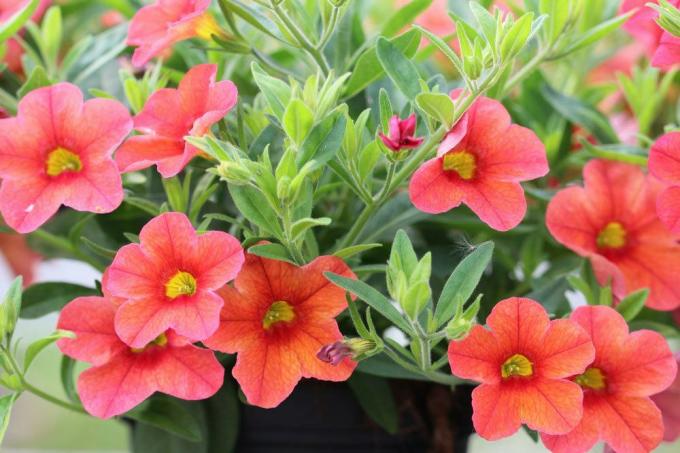
plants
Plant correctly - this is how it works.
- Pick up the pot or flower box
- place a pottery shard over the water drain
Note: The pottery shard serves as a drainage.
- Fill in one third of the rhododendron or bog soil
Tip: It is best to mix in a little more deciduous or coniferous compost.
- Create small planting pits at a distance of about 20 to 25 centimeters
- Place four to five magic bells per meter in the loose earth and press on
Note: Be sure to leave a pouring edge of about two to three centimeters free.
- Pour soft water on
to water
The magic bell typically has a high water requirement. This is because it consumes a great deal of liquid due to the sunny location it prefers. Conversely, you shouldn't water the plant excessively, as it can only cope with waterlogging with difficulty and can be damaged quickly. The best thing to do is to pour the Calibrachoa floating or to submerge the traffic light under water until no more air bubbles rise from the potting soil or potting soil.
Note: Permanently wet soil must be avoided. To do this, you use a planter that either has a good drainage system or is provided with a drainage layer.
Despite intensive watering, on hot days it may be necessary to water the mini petunia twice (morning and evening). Soft, lime-free water is necessary. In this respect, rainwater is the perfect solution. However, stale tap water is fine too.
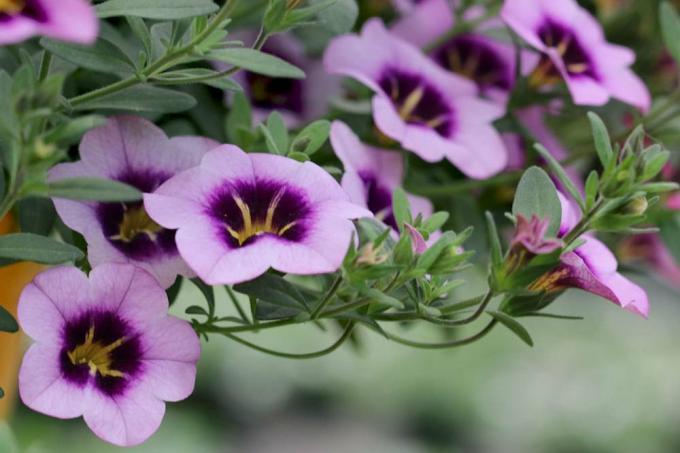
The thumb test can be used to quickly and clearly determine whether the plant needs water or not. You stick your thumb into the substrate and test whether the top one to two centimeters feel dry. If this is the case, the Calibrachoa wants to be poured.
Note: Since the magic bell has to be poured floatingly, there should not be anything sensitive to water under the planter.
Fertilize
The plant's need for nutrients is as high as its longing for water. Therefore, it should be fertilized every two weeks. Liquid fertilizers are ideal for this purpose. The chosen product is added to the watering water every two weeks, which simplifies the care of the magic bell. A bit less effort is required if you use a long-term fertilizer in the form of sticks. In any case, you need a means intended for flowering plants.
Tip: You can tell by the color of the flowers whether the mini petunia has enough iron. Pale tones indicate a defect that should be remedied quickly.
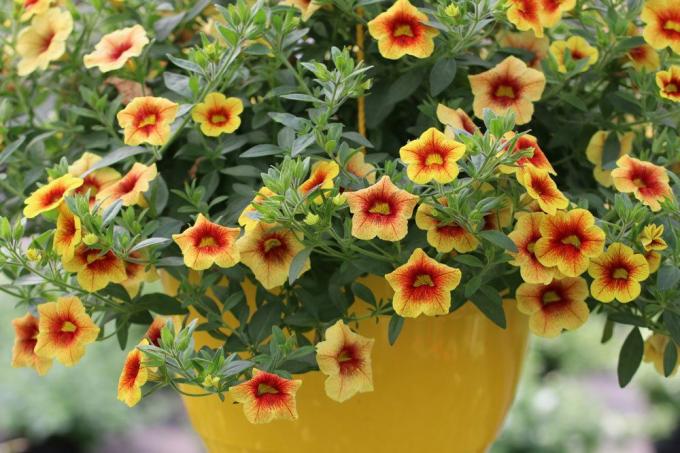
Cut
Compared to other flowering balcony plants, the mini petunia has a pleasant advantage: the special one The nature of the flowers ensures that the latter cannot be removed individually by hand after withering got to. Instead, they are simply overgrown by new, fresh buds and "disappear" by themselves.
Tip: Nevertheless, it is advisable to thin out the millionbells every now and then and cut them gently. These measures strengthen the flowering power, which in turn can intensify the splendor of the flowers. It is completely sufficient to shorten each shoot by a third every two to three weeks.
Repot
The mini petunia only needs to be repotted if you have chosen to propagate by cuttings. But there is not much to do here: You put the young plants in larger planters in spring, that's all.
Overwinter
An adult magic bell is one year old. In this respect, there is usually no wintering here. The situation is different with the young shoots that have been pulled through cuttings as part of the propagation. Ideally, they will be overwintered in the house with light and temperatures between twelve and 18 degrees Celsius. The earth must neither dry out nor be wet. It is therefore essential to ensure moderate humidity. The growing Million Bells do not need fertilization during the cold season.
Tip: Although the Calibrachoa actually functions as an annual plant, you can try wintering. Under certain conditions it is possible to save individual specimens of the magic bell for the next garden season.
These basic requirements must be met:
- Temperatures around 14 degrees Celsius
- bright room (preferably a winter garden)
- Shorten the length of the shoots to ten centimeters
- regular but economical water supply
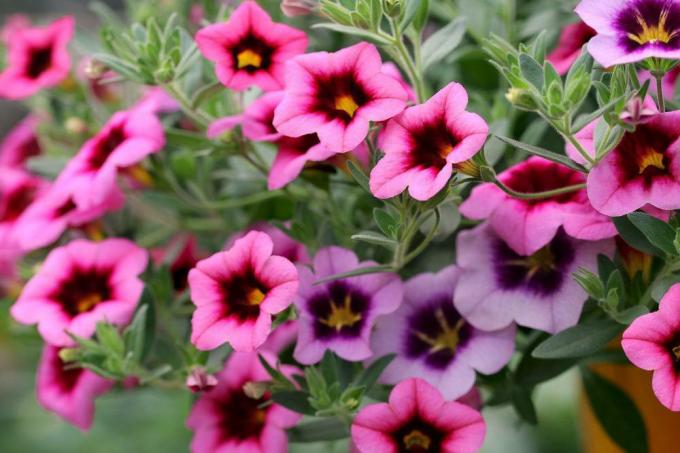
After the (successful) wintering, the plants are initially used to the direct sunlight and higher temperatures, while being protected in the house. In May it is then planted outdoors.
Basically, all Calibrachoa species are not hardy outdoors!
Multiply
There are two options to choose from for the propagation of the Calibrachoa.
- Propagation by seeds
- Propagation by cuttings
Propagation by seeds
Propagation by seeds is the more complicated variant for many. Even the extraction of the seeds is sometimes a bit cumbersome. Anyone who nevertheless decides to sow the seeds themselves has to be a little patient.
You wait until the green seed pods, which are formed as round fruiting bodies on the withered flowers, gradually turn brown. Then these are collected and taken to a dry, airy place. There the capsules open relatively quickly and release the precious seeds, which can now be shaken out without any problems. In January, the fine seeds are sown on growing or petunia soil. They are only lightly covered and moistened. Then it is best to place the whole thing on the warm, sunny to partially shaded window sill and grow the next generation of bells by May.
Propagation by cuttings
Propagation by cuttings works similarly, but much easier for most of them. The necessary shoots, which should be about ten centimeters long, are best obtained in summer. You cut them off and put them also in moderately moist flower or petunia soil. A bright, warm place then offers the optimal conditions for the gradually awakening Millionbells.
Tip: When propagating by cuttings, it is advisable to cut off all leaves about halfway. This namely promotes root growth.
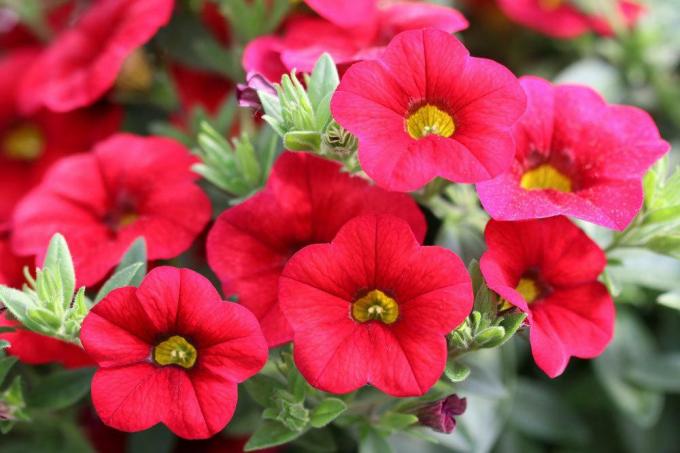
Diseases
Pests, diseases and typical care mistakes
The magic bell is in and of itself quite robust. However, it can be attacked by aphids and whiteflies. If you see these pests on the leaves of the plant, two measures are available.
- Buy insecticide based on neem oil (also called neem oil)
- attract natural predators such as ladybugs and parasitic wasps
The two methods must of course not be combined, as ladybirds and parasitic wasps also cannot tolerate the insecticide. Furthermore, diseases in the Calibrachoa cannot be ruled out. Wilting and iron deficiency are comparatively common - symptoms that generally result from mistakes in care.
Wilt
It is expressed by wilting flowers and leaves. The reason for this is usually waterlogging. In order to prevent the negative circumstance or to work against it in the event of damage that has already occurred, drainage is made and attention is paid to sufficient, but not excessive, pouring behavior.
Iron deficiency
Fading flower colors and yellow leaves indicate an iron deficiency. Fortunately, this can be compensated for fairly quickly with an appropriate fertilizer. But: The cause of the nutrient deficiency can also be calcareous water. The best thing to do is to check the hardness of the water used with a test strip from the trade and to ask if necessary to rainwater or decalcified tap water, which is the casting of the magic bell regards.
Is the magic bell poisonous?
The mini petunia belongs to the nightshade family. Like many of its relatives, it is poisonous to humans and animals. That means: If you live with small children, dogs, cats or other free-range pets, the millionbells should be placed in such a way that they are inaccessible to endangered beings. Falling leaves and flowers must also be removed immediately to minimize the risk of poisoning.

